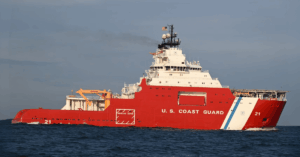The U.S. Coast Guard’s Newest Icebreaker ‘Storis’ Embarks on First Arctic Mission
The U.S. Coast Guard’s latest addition to its fleet of icebreakers, USCGC Storis (WAGB 21), has commenced its inaugural Arctic mission following a successful transit through the Panama Canal.
Marking the first procurement of a polar icebreaker by the Coast Guard in over a quarter of a century, Storis set sail from Bollinger Shipyards in Pascagoula, Mississippi, on June 3, 2025. After reaching the northern entrance of the Panama Canal on June 11, the vessel waited for 18 hours outside Limon Bay near the Gatun locks before embarking on its canal transit, which lasted approximately eight hours. Storis emerged from the Miraflores locks late on June 12.
While U.S. military vessels are typically granted expedited passage through the Panama Canal, specifics regarding Storis’ transit fees or special treatment remain undisclosed. Nonetheless, documentation confirms the icebreaker was afforded priority access during a period of light southbound canal traffic.
The vessel is anticipated to arrive in San Diego on July 2, 2025, with an official commissioning ceremony scheduled for August in Juneau, Alaska, its future homeport. Until infrastructure enhancements are completed in Juneau, Storis will temporarily operate from Seattle alongside the Coast Guard’s other two polar icebreakers.
Originally named Aiviq, the ship was acquired from Edison Chouest Offshore on December 20, 2024, and underwent modifications to enhance its communication and self-defense systems prior to deployment.
Commissioned by Captain Keith M. Ropella, who previously commanded the Polar Star (WAGB 10), Storis features a hybrid crew comprising Coast Guard personnel and civilian mariners. This icebreaker inherits the legacy of its predecessor, the original Storis, renowned for its Arctic missions spanning 64 years until decommissioning in 2007.
The procurement of Storis aligns with the Coast Guard’s “Force Design 2028” strategy, aimed at bolstering operational capacity through technological and operational reforms. The vessel’s acquisition underpins the Coast Guard’s interim capability gap mitigation until the arrival of new icebreakers projected around 2030.
The commissioning of Storis underscores the Coast Guard’s commitment to supporting Arctic and Antarctic operations, succeeding aging cutters dating back to the 1970s and 1990s. The long-term objective includes expanding the fleet to encompass eight to nine polar icebreakers, a vision that echoes former President Trump’s advocacy for up to 40 icebreakers.
Simultaneously, progress continues on the Polar Security Cutter Program, with the lead vessel, Polar Sentinel (WMSP-21), entering full production in Pascagoula, Mississippi, in May 2024. Equipped with a 45,000-horsepower diesel-electric engine, Polar Sentinel boasts icebreaking capabilities up to 8 feet thick and is armed with 12.7mm machine guns and 30mm autocannons for defense.
Furthermore, Canadian shipbuilder Davie intends to establish shipyard facilities in Galveston and Port Arthur, Texas, to support U.S. icebreaker construction. This initiative seeks to transform Texas into a hub for advanced shipbuilding, with a focus on delivering high-quality vessels on schedule and within budget to meet national security demands.
As Storis embarks on its pioneering mission, the Coast Guard’s commitment to enhancing operational capabilities and safeguarding polar regions remains steadfast, ensuring readiness for future challenges and contingencies.

